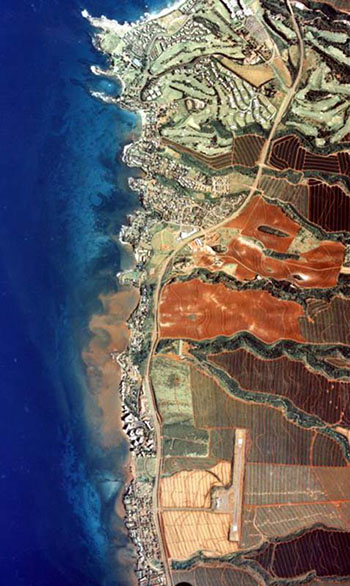- ABOUT US
- PROGRAM AREAS
- CONSERVATION APPROACH
- EDUCATION
- MULTIMEDIA
New Tools Support Ridge-to-Reef Conservation and Management

Coral reef and coastal resource managers now have two new tools to strengthen their efforts on the ground and in the water to reduce the impacts of land-based sources of pollution on coral reefs. The tools are a product of the U.S. Coral Reef Task Force Watershed Partnership Initiative.
Impacts from pollution that stem from actions on land (e.g., coastal development and agricultural runoff) are a serious issue. They can impede coral growth and reproduction, disturb ecological function, and cause disease.
"Globally, there has been very limited research that connects management actions taken in watersheds to downstream impacts in coral reef areas," Jennifer Koss, Director of the NOAA Coral Reef Conservation Program, said. "These new tools from the U.S. Coral Reef Task Force will play an important role in improving water quality and making strides in coral reef conservation."
The first is a series of ecological indicators and measurements to evaluate the success of existing watershed management efforts. The indicators look at coral communities, as well as sediment and water quality. Nearly all were selected from existing national-scale monitoring efforts by federal agencies.
The second is a user-friendly checklist that walks watershed coordinators through a series of questions to help them implement a successful ridge-to-reef watershed management plan. The checklist helps gauge support from stakeholders--including local groups and federal agencies--and documents overall progress as a ridge-to-reef watershed management plan is implemented. The checklist is meant to be completed on an annual basis to track progress.
Both tools were developed by the U.S. Coral Reef Task Force Watershed Partnership Initiative in response to a 2012 resolution that called for increased work to reduce land-based sources of pollution from entering into coastal coral reef areas.
The U.S. Coral Reef Task Force brings together representatives from 12 federal agencies, officials from state and territory governments, and delegates from three freely associated states to further coral reef conservation. The task force named three priority U.S. watershed sites - Guánica, Puerto Rico, West Maui, Hawaii, and Faga'alu, American Samoa - where it focuses efforts to reduce the impacts of land-based pollution on coral reefs.
Key partners in this effort include, NOAA Coral Reef Conservation Program, U.S. Environmental Protection Agency, U.S. Department of Interior, watershed coordinators for the priority sites, Ridge to Reefs, and the National Fish & Wildlife Foundation.
For more information, visit: https://www.coris.noaa.gov/activities/uscrtf_watershed_tools/.
About Us

The NOAA Coral Reef Conservation Program was established in 2000 by the Coral Reef Conservation Act. Headquartered in Silver Spring, Maryland, the program is part of NOAA's Office for Coastal Management.

The Coral Reef Information System (CoRIS) is the program's information portal that provides access to NOAA coral reef data and products.
Work With US
U.S. Coral Reef Task Force
Funding Opportunities
Employment
Fellowship Program
Contracting Assistance
Graphic Identifier
Featured Stories Archive

Access the archive of featured stories here...
Feedback
Thank you for visiting NOAA’s Coral Reef Conservation Program online. Please take our website satisfaction survey. We welcome your ideas, comments, and feedback. Questions? Email coralreef@noaa.gov.
Stay Connected
Contact Us
NOAA’s Coral Reef Conservation Program
SSMC4, 10th Floor
1305 East West Highway
Silver Spring, MD 20910
coralreef@noaa.gov
